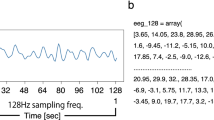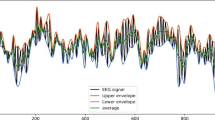Abstract
A time-frequency spectral representation (TFSR) has been used to study the nonstationary information in the EEG as an aid in determining the anesthetic depth. This paper uses a TFSR with an exponential weighting function for the purpose. Raw EEG data were collected from 10 mongrel dogs at various levels of halothane anesthesia. Depth of anesthesia was tested by observing the response to tail clamping, which is considered a supramaximal stimulus in dogs. A positive response was graded as awake (depth 0), and a negative response was graded as asleep (depth 1). The EEG obtained during a period of 30 sec tail clamp was processed into TFSRs. It was observed that at depth 0, the spectrum becomes localized in time and frequency. The percentage of energy in the delta (1–3.5 Hz) and theta (3.5–7.5 Hz) frequency bands increased. At depth 1, the spectrum remained unchanged throughout the period of tail clamp. The performance of the TFSR in detecting the patient’s awareness was also compared with the power spectrum. It was concluded that under certain anesthetic conditions, the TFSR is superior to the power spectrum.
Similar content being viewed by others
References
Cerutti, S., D. Liberati, and P. Mascellani. Parameter extraction in EEG processing during riskful neurosurgical operations.Signal Processing 9:25–35, 1985.
Choi, H. I., and W. J. Williams. Improved time-frequency representation of multicomponent signals using exponential kernels.IEEE Trans. Acoust. Speech Signal Processing 37: 862–871, 1989.
Claasen, T. A. C. M., and W. F. G. Mecklenbräuker. The wigner distribution: a tool for time-frequency signal analysis: Part I.Philips J. Res. 35:217–250, 1980.
Classen, T. A. C. M., and W. F. G. Mecklenbräuker. The wigner distribution: a tool for time-frequency signal analysis: Part II.Philips J. Res. 5:276–300, 1980.
Classen, T. A. C. M., and W. F. G. Mecklenbräuker. The wigner distribution: a tool for time-frequency signal analysis: Part III.Philips J. Res. 5:372–389, 1980.
Cohen, L. Generalized phase-space distribution function.J. Math. Phys. 7:781–786, 1966.
Cohen, L. Time-Frequency distributions—a review.Proc. IEEE 77:941–981, 1989.
Dutton, R., W. D. Smith, and N. Smith. Does the EEG predict anesthetic depth better than cardiovascular variables?Anesthesiology 73:A532, Sep, 1990.
Eger, E. I., L. J. Saidman, and B. Brandstater. Minimum alveolar anesthetic concentration: a standard of anesthetic potency.Anesthesiology 26:756–763, 1965.
Gath, I., C. Feuerstein, D. T. Pham, and G. Rondouin. On the tracking of rapid dynamic changes in seizure EEGIEEE Trans. Biomed. Eng. 39:952–958, 1992.
Ghoneim, M. M., and R. I. Block. Learning and consciousness during general anesthesia.Anesthesiology 76: 279–305, 1992.
Ghouri, A. F., T. G. Monk, and P. F. White. Electroencephalogram spectral edge frequency, lower esophageal contractility and autonomic responsiveness during general anesthesia.J. of Clin. Monitoring 9:176–185, 1993.
Gibbs, F. A., E. L. Gibbs, and W. G. Lenox. Effect of the Electroencephalogram of certain drugs which influence nervous activity.Arch. Intern. Med. 60:154–166, 1937.
Harris, F. H. On the use of windows for harmonic analysis with the discrete fourier transform.Proceedings of the IEEE 66:51–83, 1978.
Jansen, B. H., J. R. Bourne, and J. Ward. Autoregressive estimation of short segment spectra for computerized EEG analysis.IEEE Trans. Biomed. Eng. 28:630–638, 1981.
Kawabata, N. A non-stationary analysis of the Electrocorticogram.IEEE Trans. Biomed. Eng. 20:444–452, 1973.
Koch, E., P. Bischoff U. Pichlmeier, and J. S. Esch. Surgical stimulation induces changes in brain electrical activity during isoflurane/nitrous oxide anesthesia.Anesthesiology 80:1026–1034, 1994.
Klein, F. F., and D. A. Davis. The use of time domain analyzed EEG in conjunction with cardiovascular parameters for monitoring anesthetic levels.IEEE Trans. Biomed. Eng. 28:36–40, 1981.
Koenig, R., H. Dunn, and L. Y. Lacy. The Sound spectrograph.J. Acoust. Soc. Amer. 18:19–49, 1946.
Martin, J. T., A. Faulkoner, and R. G. Bickford. Electroencephalography in anesthesiology.Anesthesiology 20:359–376, 1959.
Martin, W., and P. Flandrin. Wigner-Ville spectral analysis of nonstationary processes.IEEE Trans. Acoust. Speech Signal Processing 33:1461–1470, 1985.
McEwen, J., G. B. Anderson, M. Low, and L. Jenkins. Monitoring the level of anesthesia by automatic analysis of spontaneous EEG activity.IEEE Trans. Biomed. Eng. 22: 299–305 1975.
McEwen, J. A., and G. B. Anderson. Modeling the stationarity and gaussianity of spontaneous Electroencephalographic activity.IEEE Trans. Biomed. Eng. 22:361–369, 1975.
Oppenhiem, A. V., and R. W. Schaffer. Digital Signal Processing. Englewood Cliffs: Prentice Hall International, 1989, pp. 337–375.
Page, C. H. Instantaneous power spectra.J. Appl. Phys. 23:103–106, 1952.
Prince, D. A., and S. Shanzer. Effects of anesthetics upon the EEG response to reticular stimulation. Patterns of slow synchrony.Electroenceph. and Clin. Neurophysiol. 21: 578–588, 1966.
Rihaczek, W. Signal energy distribution in time and frequency.IEEE Trans. Informat. Theory. 14:369–374, 1968.
Redding, R. W. Canine Electroencephalography. In: Canine Neurology, edited by B. F. Hoerlin, W. B. Saunders, Philadelphia, 1965, pp. 55–70.
Sharma, A., and R. J. Roy. Analysis of hidden nodes in a neural network trained for pattern classification of EEG data.Proc. of the 15th Annual International Conf. of the IEEE-EMBS 1:252–253, 1993.
Schwilden, H., and H. Stoechel. Effective therapeutic infusion produced by closed-loop feedback control of methohexital administration during total intravenous anesthesia with fentanyl.Anesthesiology 73:225–229, 1990.
Sidi, A., P. Halimi, and S. Cotev. Estimating anesthetic depth by Electroencephalography during anesthetic induction and intubation in patients undergoing cardiac surgery.J. Clin. Anesth. 2:101–107, 1990.
Srebro, R. Reduction of EEG activity caused by a light flash.Electroenceph. and Clin. Neurophysiol. 54:707–710, 1982.
Thomsen, C. E., K. N. Christensen, and A. Rosenfalck. Computerized monitoring of depth of anesthesia with Isoflurane.British Jour. of Anesthesia 63:36–43, 1989.
Veselis, R. A., R. Reinsel, R. Alagesan, R. Heino, and R. Bedford. The EEG as a monitor of Midazalom Amnesia: changes in power and topography as a function of amnesic state.Anesthesiology 74:866–874, 1991.
Vishnoi, R., and R. J. Roy. Adaptive control of closed circuit anesthesia.IEEE Trans. Biomed. Eng. 38:39–47, 1991.
Zaveri, H. P., W. J. Williams L. D. Iasemidis, and J. Sackellares. Time-Frequency representation electrocorticograms in temporal lobe epilepsy.IEEE Trans. Biomed. Eng. 39:502–509, 1992.
Zbinden, A. M., M. Maggiorini, S. Petersen-Felix, Lauber, R., Thomson, D. A., and Minder, C. E. Anesthetic depth defined using multiple noxious stimuli during isoflurane/oxygen anesthesia. I. Motor reactions.Anesthesiology 80: 253–260, 1994.
Author information
Authors and Affiliations
Rights and permissions
About this article
Cite this article
Nayak, A., Roy, R.J. & Sharma, A. Time-frequency spectral representation of the EEG as an Aid in the detection of depth of anesthesia. Ann Biomed Eng 22, 501–513 (1994). https://doi.org/10.1007/BF02367086
Received:
Revised:
Accepted:
Issue Date:
DOI: https://doi.org/10.1007/BF02367086




